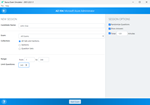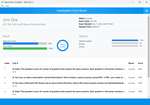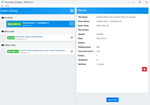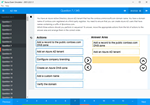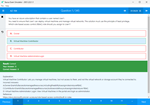Download VMware Certified Advanced Professional 6 - Data Center Virtualization Design.3V0-622.PracticeTest.2018-07-30.4q.tqb
| Vendor: | VMware |
| Exam Code: | 3V0-622 |
| Exam Name: | VMware Certified Advanced Professional 6 - Data Center Virtualization Design |
| Date: | Jul 30, 2018 |
| File Size: | 4 MB |
How to open TQB files?
Files with TQB (Taurus Question Bank) extension can be opened by Taurus Exam Studio.
Purchase
Coupon: TAURUSSIM_20OFF
Discount: 20%
Demo Questions
Question 1
Customer Requirements:
You have been tasked with creating a vSphere 6.x data center design for an organization. The organization is looking to virtualize their physical email application. The company has provided a list of requirements that must be included in the design:
- E-mail database is replicated between two servers at a logical level, with no shared disk configurations.
- E-mail databases meet corporate criteria for LUN provisioning, and must reside directly on storage array.
- Operating system disks do not meet corporate requirements for LUN provisioning, and per policy should not share the same VMFS storage location for redundancy reasons.
- Internal users currently point to three Client Access Servers for load balancing.
- External users currently point to three Web Client Access Servers for load balancing.
- Customer requires discrete hardware to provide security between internal servers and externally available servers, as well as between externally available servers, and client connections from offsite.
Design Requirements:
Create a solution that shows the service dependencies required for virtualizing the email application, including:
- All required storage for Mail DB VM(s) only
- All required network and security connection(s)
- All required virtual machine(s)
- All required user(s)
Place all items in required container(s). Connect VMFS datastore(s) to required virtual machine(s). Place disk(s) over the required storage type(s). Connect firewall(s) to container(s).














- See the solution below
Correct answer: A
Explanation:







Question 2
Customer Requirements:
You have been tasked with creating a vSphere 6.x data center design for an organization. The organization wants three defined virtual machine performance levels:
- Gold Tier – High workload VMs
- Silver Tier – Medium workload VMs
- Bronze Tier – Development workload VMs
The organization has eight ESXi hosts that can be used in the design. Five of the hosts are older “medium performance” hosts, while the last 3 are newer “high performance” hosts that provide better resources when compared to the other hosts. The organization has provided a list of requirements that the design must meet:
- Gold Tier virtual machines should run only on high performance servers, unless no high performance servers are available. They should also be allocated 75% of overall available resources regardless of placement.
- Silver Tier virtual machines should run only on medium performance servers, unless no medium performance servers are available. They should also be allocated 25% of overall available resources regardless of placement.
- Bronze Tier virtual machines should run only on medium performance servers. They should also receive a 35% subset of resources from those allocated to the Silver Tier.
Design Requirements:
Create a logical design that shows resource allocation and cluster policies needed to meet the customer’s requirements. The design should include:
- All required server(s)
- All required resource(s)
Place host(s) in the required DRS group(s). Place virtual machines in the appropriate resource pool(s). Connect parent to child resource pool connector(s) where needed. Connect the appropriate affinity connector(s) where needed.
















- See the solution below
Correct answer: A
Explanation:









Question 3
You have been tasked with creating a vSphere 6.x design for an organization. The customer wants to ensure isolation in the network but does not know when to incorporate physical networks, VLANs and PVLANs.
Evaluate the design requirement and determine the isolation method to satisfy the design.
Match each Design Requirement on the left by dragging the red Requirement buttons (R1-R5) over the text of the appropriate Isolation Method.
NOTE: Multiple Design Requirements may fit each Isolation Method.
Correct answer: To work with this question, an Exam Simulator is required.
Question 4
Customer Requirements:
You have been tasked with creating a vSphere 6.x data center design for an organization. The organization has provided a number of Business Continuity and Disaster Recovery (BC/DR) requirements to meet their established Service Level Agreements (SLAs). The preliminary design will include two sites.
Production Site:
- 6 ESXi hosts in two clusters
- A Fiber Channel storage array with three types of storage:
- Flash storage
- 15K SAS drives with vFlash Read Cache
- SATA drives in RAID 5 configuration
Secondary Site:
- 3 ESXi hosts in a single cluster
- A Fiber Channel storage array of the same type and with the same configuration as that of the production site
The details of the organization’s SLAs include:
- Gold: Maximize read/write storage performance and provide automated offsite recovery with an RPO < 15 minutes.
- Silver: Maximize read performance and provide automated offsite recovery with an RPO from 15 minutes to 24 hours.
- Bronze: No performance requirement. Onsite recovery with no specific RPO.
The organization has a number of web-based multi-tier applications that are governed by their SLAs. The workloads in these applications and their SLA assignments include:
- Database workloads – Gold
- Application workloads – Silver
- Web workloads – Bronze
Note that Web servers only contain static information that is site specific.
Design Requirements:
Create a design that incorporates the required elements:
- Place an SLA container for each of the appropriate SLAs into the appropriate sites.
- Place the appropriate storage type(s) for each SLA into the SLA container.
- Place the appropriate workload(s) into the SLA containers.
- Place the appropriate BCDR components into the SLA containers.
- Connect any replicated storage between the two sites using the appropriate replication connector.














- See the solution below
Correct answer: A
Explanation:
Primary Secondary Primary









Secondary




HOW TO OPEN VCE FILES
Use VCE Exam Simulator to open VCE files

HOW TO OPEN VCEX FILES
Use ProfExam Simulator to open VCEX files


ProfExam at a 20% markdown
You have the opportunity to purchase ProfExam at a 20% reduced price
Get Now!